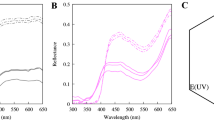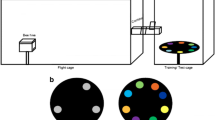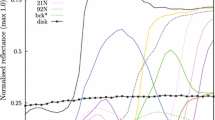Abstract
Red flowers are a defining character of the bird-pollination syndrome. Birds do not, however, innately prefer red, suggesting that rather than attracting birds, red flowers may serve to exclude other visitors (e.g., bumblebees). Bees are sometimes considered “blind” to red, but studies have in fact documented both blue and red preferences in various bee species. These mixed results may be an effect of overly simplistic lab settings. We hypothesized that bees might readily locate red flowers in a simple laboratory environment, but struggle to find the same flowers in a complex, foliated setting. We tested the effects of environmental complexity on visitation to red and blue artificial flowers and on the foraging rate of captive worker bumblebees (Bombus impatiens). Bees made significantly fewer visits to red flowers when foraging in a complex environment with artificial green foliage, suggesting that red becomes harder to locate in this context than in a simple, leafless environment. Bees also foraged more slowly, on average, in the complex environment, although the difference was apparent only among experienced bees. Our findings provide a possible explanation for previous laboratory tests finding no colour preference in bumblebees. This “contextual colour-blindness” of bees supports the hypothesis that red evolved as a mechanism for plants to avoid visitation by bees, favouring bird pollination instead.




Similar content being viewed by others
References
Baker HG (1975) Sugar concentration in nectars from hummingbird flowers. Biotropica 7(1):37–41
Bates D, Maechler M, Bolker B et al (2015) Fitting linear mixed-effects models using lme4. J Stat Softw 67(1):1–48
Bené F (1945) The role of learning in the feeding behaviour of black-chinned hummingbirds. The Condor 47:3–22
Bolker BM, Mrooks ME, Clark CJ et al (2009) Generalized linear mixed models: a practical guide for ecology and evolution. Trends Ecol Evol 24(3):127–135
Bradshaw HD Jr, Wilbert SM, Otto KG et al (2002) Genetic map** of floral traits associated with reproductive isolation in monkeyflowers (Mimulus). Nature 376:762–765
Briscoe AD, Chittka L (2001) The evolution of color vision in insects. Annu Rev Entomol 46:471–510
Burns JG, Dyer AG (2008) Diversity of speed-accuracy strategies benefits social insects. Curr Biol 18(20):R953–R954
Castellanos MC, Wilson P, Thomson JD (2003) Pollen transfer by hummingbirds and bumblebees, and the divergence of pollination modes in Penstemon. Evolution 57(12):2742–2752
Castellanos MC, Wilson P, Thomson JD (2004) ‘Anti-bee’ and ‘pro-bird’ changes during the evolution of hummingbird pollination in Penstemon flowers. J Evol Biol 17:876–885
Chittka L (1992) The colour hexagon: a chromaticity diagram based on photoreceptor excitations as a generalized representation of colour opponency. J Comp Physiol A 170:533–543
Chittka L, Waser NM (1997) Why red flowers are not invisible to bees. Israel J Plant Sci 45:169–183
Chittka L, Spaethe J, Schmidt A et al (2001) Adaptation, constraint, and chance in the evolution of flower color and pollinator color vision. In: Chittka L, Thomson JD (eds) Cognitive ecology of pollination. Cambridge University Press, Cambridge, pp 106–126
Chittka L, Ings TC, Raine NE (2004) Chance and adaptation in the evolution of island bumblebee behaviour. Popul Ecol 46:243–251
Collias NE, Collias EC (1968) Anna’s hummingbirds trained to select different colors in feeding. Condor 70(3):273–274
Core Team R (2015) R: A language and environment for statistical computing. R Foundation for Statistical Computing, Vienna
Crepet WL (1984) Advanced (constant) insect pollination mechanisms: patterns of evolution and implications vis-à-vis angiosperm diversity. Ann Missouri Bot Gard 71(2):607–630
Faegri K, Van Der Pijl L (1966) The principles of pollination ecology. Pergamon Press, London
Fenster CB, Armbruster WS, Wilson P et al (2004) Pollination syndromes and floral specialization. Annu Rev Ecol Evol Syst 35:375–403
Fenster CB, Reynolds RJ, Williams CW et al (2015) Quantifying hummingbird preference for floral trait combinations: the role of selection on trait interactions in the evolution of pollination syndromes. Evolution 69(5):1113–1127
Forrest J, Thomson JD (2009) Background complexity affects colour preference in bumblebees. Naturwissenschaften 96:921–925
Gegear RJ, Burns JG (2007) The birds, the bees, and the virtual flowers: can pollinator behavior drive ecological speciation in flowering plants? Am Nat 170(4):551–566
Gegear RJ, Burns R, Swoboda-Bhattarai KA (2017) “Hummingbird” floral traits interact synergistically to discourage visitation by bumble bee foragers. Ecology 98(2):489–499
Gomez D (2006) AVICOL, a program to analyse spectrometric data. Available from http://sites.google.com/site/avicolprogram/
Grant K (1966) A hypothesis concerning the prevalence of red coloration in California hummingbird flowers. Am Nat 100(911):85–97
Grant KA, Grant V (1968) Hummingbirds and their flowers. Columbia University Press, New York
Hargreaves AL, Harder LD, Johnson SD (2009) Consumptive emasculation: the ecological and evolutionary consequences of pollen theft. Biol Rev 84:259–276
Hopkins R, Rausher MD (2011) Identification of two genes causing reinforcement in the Texas wildflower Phlox drummondii. Nature 469:411–414
Irwin RE, Bronstein JL, Manson JS et al (2010) Nectar robbing: ecological and evolutionary perspectives. Annu Rev Ecol Evol Syst 41:271–292
Kuznetsova A, Brockhoff PB, Christensen RHB (2016) lmerTest: tests in linear mixed effects models. R package version 2.0–32. CRAN.R-project.org/package = lmerTest
Lenth R (2016) Least-squares means: the R package lsmeans. J Stat Soft 69:1–33
Lunau K, Papiorek S, Eltz T et al (2011) Avoidance of achromatic colours by bees provides a private niche for hummingbirds. J Exp Biol 214:1607–1612
Miller RS, Miller RE (1971) Feeding activity and color preference of ruby-throated hummingbirds. Condor 73:309–313
Nakazato T, Rieseberg LH, Wood TE (2013) The genetic basis of speciation in the Giliopsis lineage of Ipomopsis (Polemoniaceae). Heredity 111:227–237
Peitsch D, Feitz A, Hertel H et al (1992) The spectral input systems of hymenopteran insects and their receptor-based colour vision. J Comp Physiol A 170:23–40
Raine NE, Ings TC, Dornhaus A et al (2006) Adaptation, genetic drift, pleiotropy, and history in the evolution of bee foraging behavior. Adv Study Behav 36:305–354
Rodríguez-Gironés MA, Santamaría L (2004) Why are so many bird flowers red? PLoS Biol 2(10):1515–1519
Santamaría L, Rodríguez-Gironés MA (2015) Are flowers red in teeth and claw? Exploitation barriers and the antagonist nature of mutualisms. Evol Ecol 29:311–322
Sherman AR (1913) Experiments in feeding hummingbirds during seven summers. Wilson Bull 25(4):153–166
Shrestha M, Dyer AG, Burd M (2013) Evaluating the spectral discrimination capabilities of different pollinators and their effect on the evolution of flower colors. Commun Integr Biol 6(3):e24000
Skorupski P, Chittka L (2010) Photoreceptor spectral sensitivity in the bumblebee, Bombus impatiens (Hymenoptera: Apidae). PLoS ONE 5(8):e12049
Smith SD, Rausher MD (2011) Gene loss and parallel evolution contribute to species difference in flower color. Mol Biol Evol 28(10):2799–2810
Spaethe J, Tautz J, Chittka L (2001) Visual constraints in foraging bumblebees: flower size and color affect search time and flight behavior. PNAS 98(7):3898–3903
Stavenga DG, Smits RP, Hoenders BJ (1993) Simple exponential functions describing the absorbance bands of visual pigment spectra. Vis Res 22(8):1011–1017
Stiles FG (1976) Taste preferences, colour preferences, and flower choice in hummingbirds. Condor 78:10–26
Thomson JD (2003) When is it mutualism? Am Nat 162:S1–S9
Thomson JD, Wilson P, Valenzuela M et al (2000) Pollen presentation and pollination syndromes, with special reference to Penstemon. Plant Species Biol 15:11–29
Van der Niet T, Johnson SD (2012) Phylogenetic evidence for pollinator-driven diversification of angiosperms. Trends Ecol Evol 27(6):353–361
Warren J, Mackenzie S (2001) Why are all colour combinations not equally represented as flower-colour polymorphisms. New Phytol 151:237–241
Wessinger CA, Rausher MD (2012) Lessons from flower colour evolution on targets of selection. J Exp Bot 63:5741–5749
Wessinger CA, Hileman LC, Rausher MD (2014) Identification of major quantitative trait loci underlying floral pollination syndrome divergence in Penstemon. Philos Trans R Soc Lond B Biol Sci 369:20130349
Whittall JB, Hodges SA (2007) Pollinator shifts drive icnreasingly long nectar spurs in columbine flowers. Nature 447:706–709
Zhang H, Lu N, Feng C et al (2011) On fitting generalized linear mixed-effects models for binary responses using different statistical packages. Stat Med 30:2562–2572
Acknowledgements
We thank C.-A. Darveau for facilities. We also thank Biobest for bees and Anna Tran for her help in caring for the bees and her advice on creating the colour hexagon. Funding was provided by the University of Ottawa.
Author information
Authors and Affiliations
Corresponding author
Electronic supplementary material
Below is the link to the electronic supplementary material.
Rights and permissions
About this article
Cite this article
Rivest, S.A., Austen, E.J. & Forrest, J.R.K. Foliage affects colour preference in bumblebees (Bombus impatiens): a test in a three-dimensional artificial environment. Evol Ecol 31, 435–446 (2017). https://doi.org/10.1007/s10682-017-9893-4
Received:
Accepted:
Published:
Issue Date:
DOI: https://doi.org/10.1007/s10682-017-9893-4




